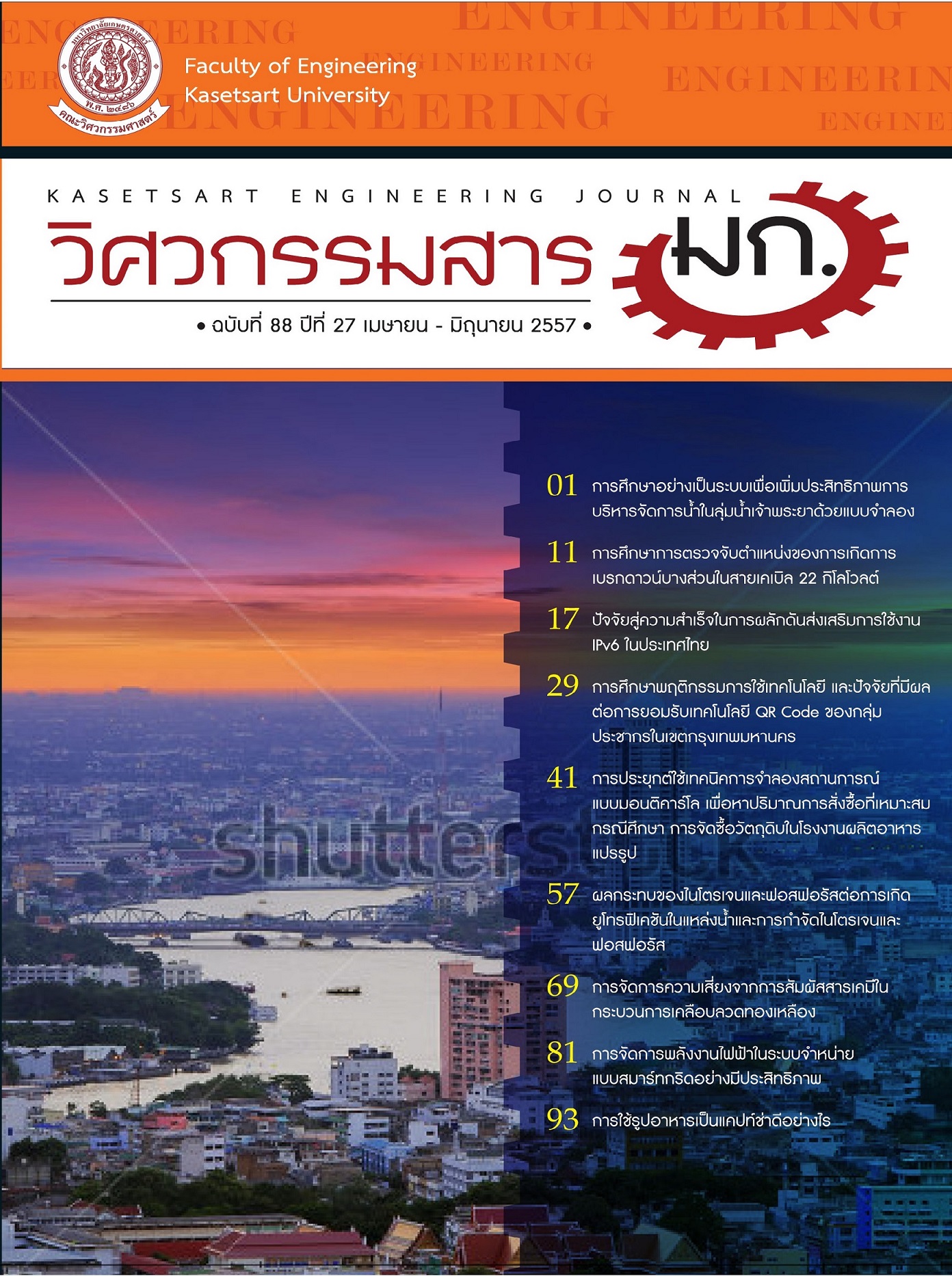ผลกระทบของไนโตรเจนและฟอสฟอรัสต่อการเกิดยูโทรฟิเคชันในแหล่งน้ำและการกำจัดไนโตรเจนและฟอสฟอรัส
Keywords:
ไนโตรเจน, ฟอสฟอรัส, ยูโทรฟิเคชัน, การบำบัดน้ำเสีย, nitrogen, phosphorus, eutrophication, wastewater treatmentAbstract
สารประกอบไนโตรเจนและฟอสฟอรัสในปริมาณมากที่เกิดจากกิจกรรมต่างๆของมนุษย์ เช่น การเกษตร ชุมชน และโรงงานอุตสาหกรรมที่ปนเปื้อนลงสู่แหล่งน้ำ เป็นสาเหตุของการเกิดแพลงก์ตอนบลูม หรือยูโทรฟิเคชันในแหล่งน้ำจืดการบลูมของแพลงก์ตอนพืชก่อให้เกิดปัญหาทางลบมากมายทั้งทางด้านเศรษฐกิจ สังคม และสิ่งแวดล้อม ปัญหาที่สำคัญได้แก่ การสูญเสียความหลากหลายทางชีวภาพของทั้งพืช และสัตว์เนื่องจากสภาพแวดล้อมไม่เหมาะสมส่งผลต่อระบบการกรองน้ำสำหรับแหล่งน้ำดิบในการทำน้ำประปา นอกจากนั้นแพลงก์ตอนบลูมโดยเฉพาะอย่างยิ่งที่เกิดจากสาหร่ายสีเขียวแกมน้ำเงินยังมีการสร้างสารพิษ เช่น microcystins, anatoxin-a และ homoanatoxin-a ซึ่งส่งผลกระทบโดยตรงต่อสุขภาพของมนุษย์และสัตว์ การเกิดยูโทรฟิเคชันยังทำให้แหล่งน้ำสูญเสียทัศนียภาพและความสวยงามด้านการพักผ่อนหย่อนใจ เนื่องจากสีและกลิ่นที่ไม่พึงประสงค์ของแพลงก์ตอนพืชที่เน่าสลายและทำให้ไม่สามารถทำกิจกรรมทางน้ำในรูปแบบต่างๆ ได้ เช่น การว่ายน้ำ ด้วยปัญหาที่เกิดขึ้นจึงได้มีแนวความคิดในการกำจัดไนโตรเจนและฟอสฟอรัสจากน้ำทิ้งชุมชนและอุตสาหกรรมซึ่งยังเป็นเรื่องค่อนข้างใหม่สำหรับประเทศไทย เพราะในปัจจุบันประเทศไทยมีเฉพาะมาตรฐานน้ำทิ้งที่พิจารณาจากค่าบีโอดีเป็นประเด็นสำคัญ ส่วนค่ามาตรฐานน้ำทิ้งในรูปของไนโตรเจนเน้นที่รูปทีเคเอ็น แต่ไม่มีค่าของปริมาณไนโตรเจนทั้งหมด ซึ่งไม่เพียงพอต่อการแก้ไขปัญหาสิ่งแวดล้อม ถ้ามีการควบคุมปริมาณน้ำทิ้งให้มีค่าไนโตรเจนและฟอสฟอรัสอยู่ในระดับต่ำแล้วอาจช่วยทำให้สามารถนำน้ำกลับมาใช้ซ้ำมีความเป็นไปได้สูง ซึ่งช่วยประหยัดการใช้น้ำดิบที่จะใช้ในการผลิตน้ำประปา หรือสามารถนำไปทำประโยชน์อย่างอื่นเช่น น้ำเพื่อการเกษตร และที่สำคัญยังเป็นการลดปัญหาการเกิดยูโทรฟิเคชันในแหล่งน้ำจืดได้อีกด้วย
Effects of Nitrogen and Phosphorus on Eutrophication in Water Bodies and Nitrogen and Phosphorus Removal
Excessive amounts of nitrogen (N) and phosphorus (P) compounds from human activities such as agriculture, residential areas and industry can cause plankton bloom or eutrophication in freshwater bodies. The bloom of phytoplankton causes many negative problems on economy, society and environment. The major problems caused by eutrophication include loss of biodiversity of both plants and animals due to improper environmental conditions, problems of water filtration systems for drinking water. The phytoplankton bloom of blue green algae in particular also creates toxins such as microcystins, anatoxin-a and homoanatoxin-a, which directly affect the health of humans and animals. Moreover, eutrophication results in the loss of beautiful scenery due to unpleasant hue and odor caused by rotten algae and influences recreational activities such as swimming. Due to adverse impact of eutrophication, a new concept in the treatment of nitrogen and phosphorus from sewage of industry and community is introduced, which is relatively new to Thailand. Presently Thailand has an effluent standard for BOD and TKN but no TN.These standards that might not be sufficient to solve water pollution problems. If there is a new standard set for nitrogen and phosphorus, then the effluent will be able to re-use and thus saving the raw water to use in the drinking water. It will also be beneficial to agriculture and most importantly, low N and P from wastewater treatment will help to reduce the problems of eutrophication in freshwater bodies.


